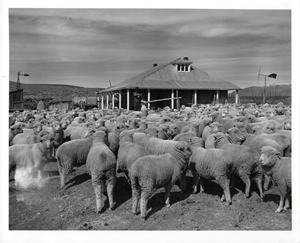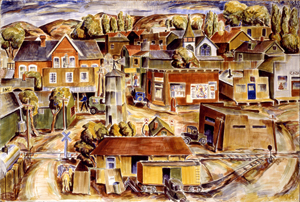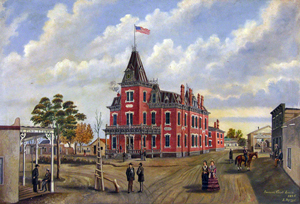 With Mexican independence in 1821, New Mexico’s period of isolation ended. Trade on the Santa Fe Trail brought new people, cultures and materials. Glass, nails, hardware and tools were finally available.
With Mexican independence in 1821, New Mexico’s period of isolation ended. Trade on the Santa Fe Trail brought new people, cultures and materials. Glass, nails, hardware and tools were finally available.
 In 1848, New Mexico became an official territory of the United States. American visitors who arrived in Santa Fe via the Santa Fe Trail did not always appreciate the native architecture. Some even said Santa Fe looked like a prairie dog town! Americans brought in milled posts and trim to make the buildings look more European, and built Greek Revival style buildings with white columns and classical proportions. U.S. military forts and government buildings adopted this style, now known as “Territorial.” Churches were also influenced by European design, and Bishop Lamy, who came from France, built Santa Fe’s St. Francis cathedral in the Romanesque Revival style.
In 1848, New Mexico became an official territory of the United States. American visitors who arrived in Santa Fe via the Santa Fe Trail did not always appreciate the native architecture. Some even said Santa Fe looked like a prairie dog town! Americans brought in milled posts and trim to make the buildings look more European, and built Greek Revival style buildings with white columns and classical proportions. U.S. military forts and government buildings adopted this style, now known as “Territorial.” Churches were also influenced by European design, and Bishop Lamy, who came from France, built Santa Fe’s St. Francis cathedral in the Romanesque Revival style.
 In 1880, the railroad began to influence the architectural styles in new settlements. Towns built along the railroad like Deming, Albuquerque and Las Vegas resembled small Midwestern towns with Victorian houses, pitched metal roofing, and front porches. Towns not along the railroad, such as Santa Fe and Taos, retained more of their regional character.
In 1880, the railroad began to influence the architectural styles in new settlements. Towns built along the railroad like Deming, Albuquerque and Las Vegas resembled small Midwestern towns with Victorian houses, pitched metal roofing, and front porches. Towns not along the railroad, such as Santa Fe and Taos, retained more of their regional character.
